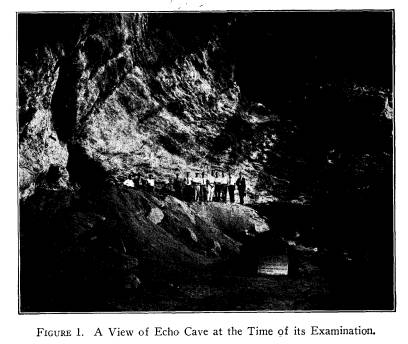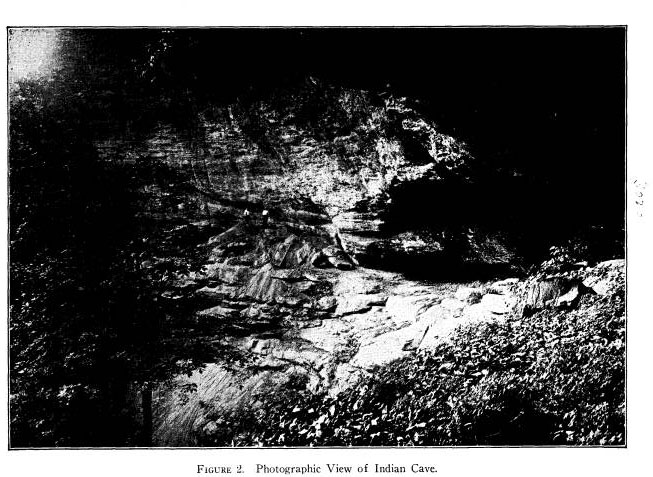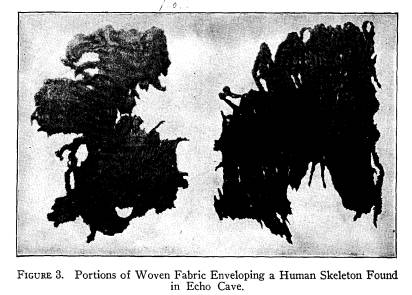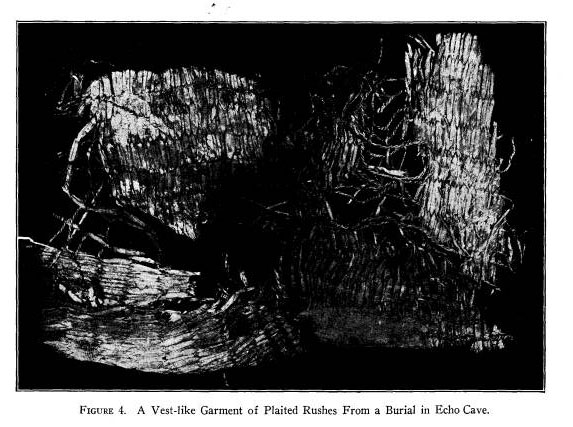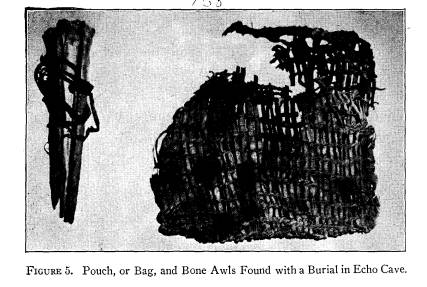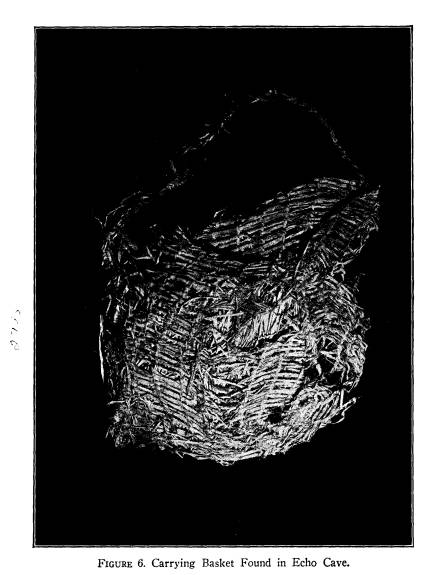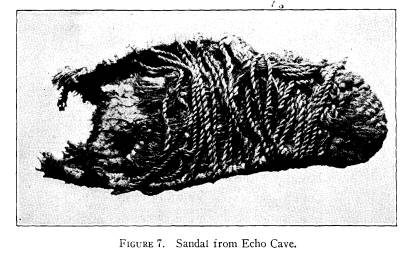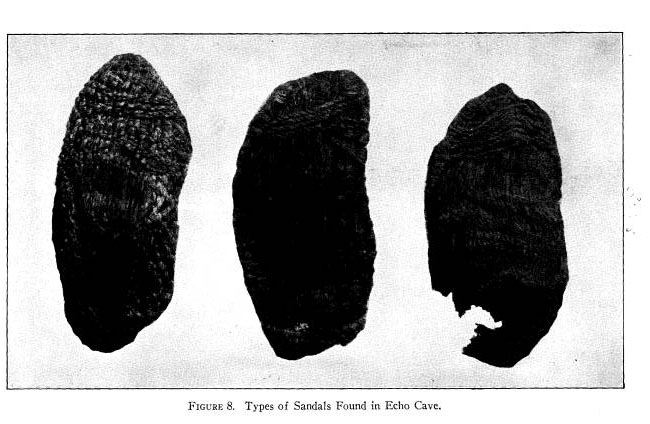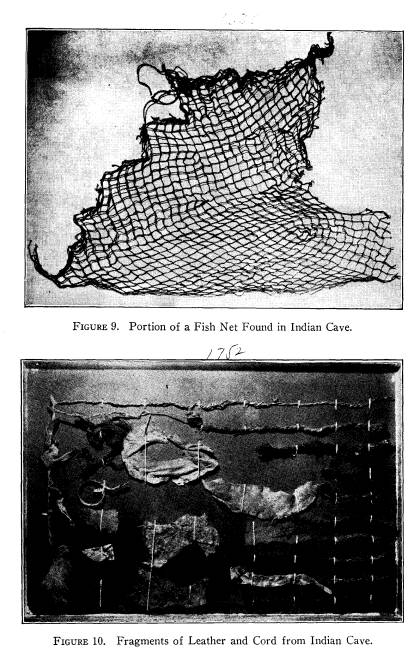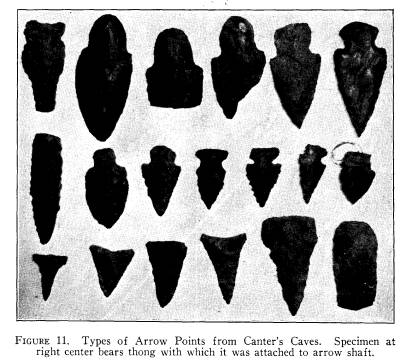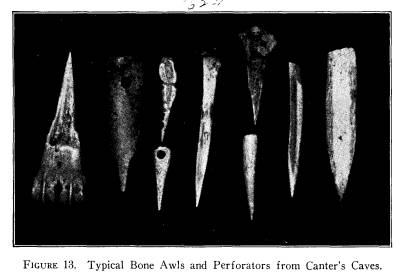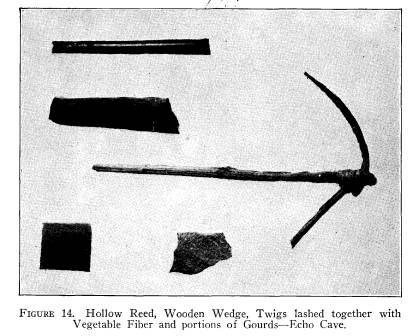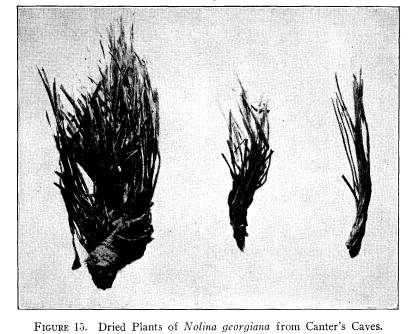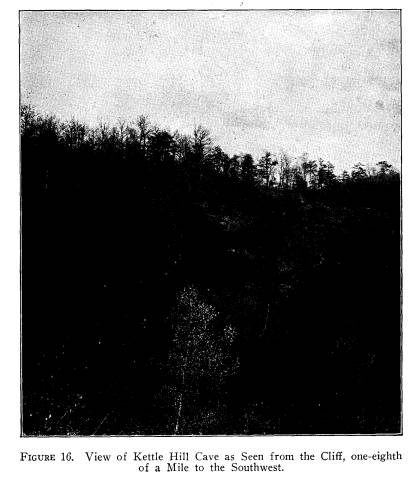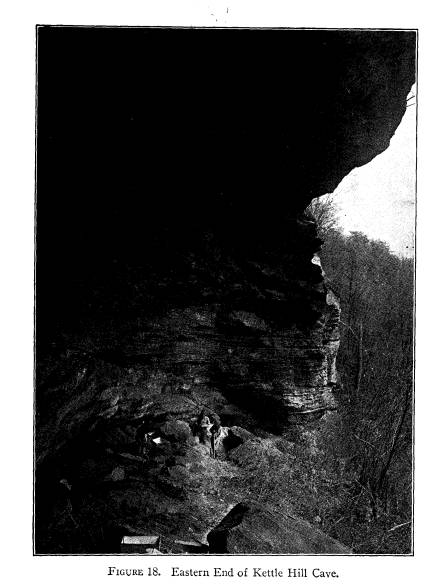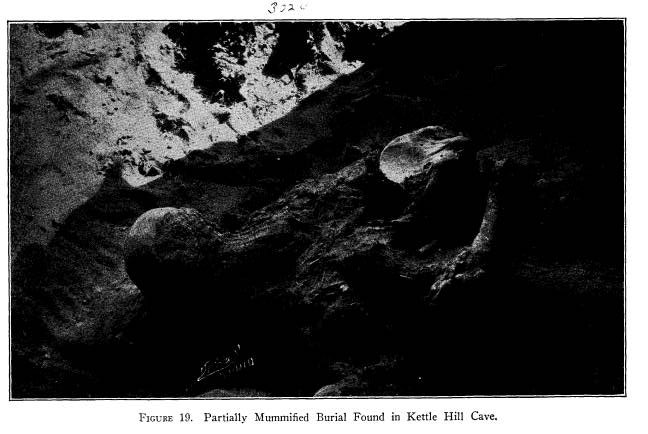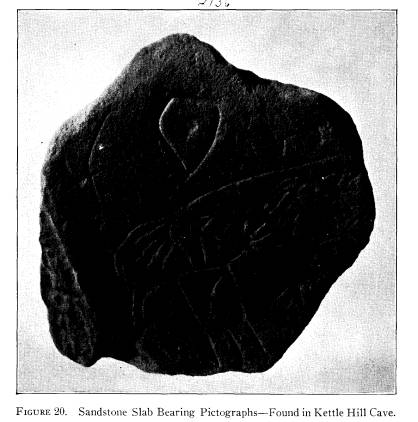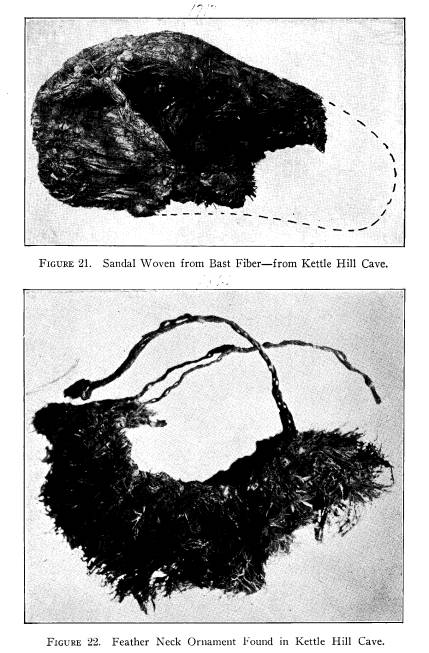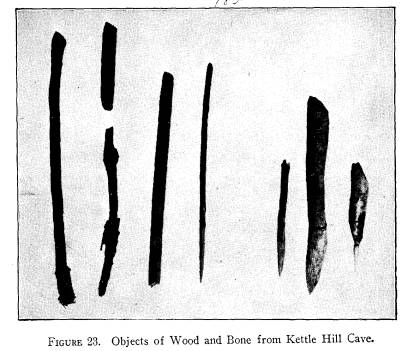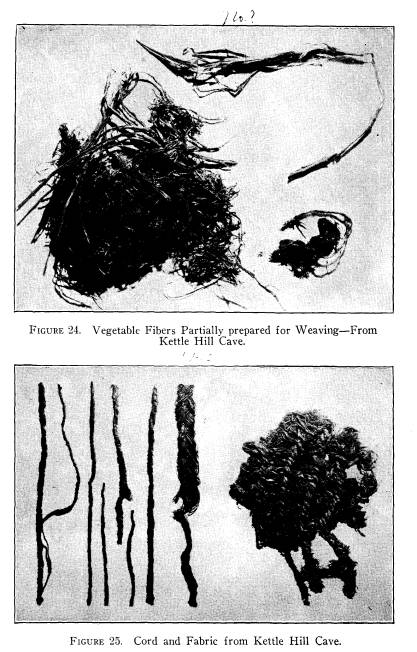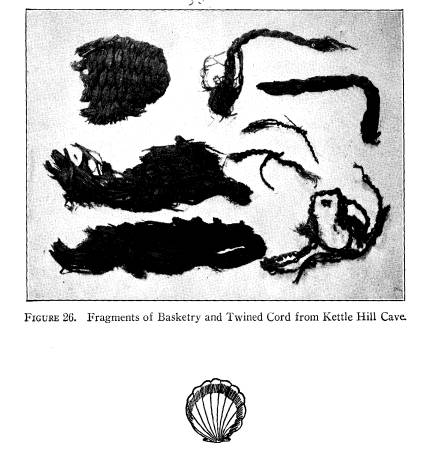Ohio History Journal
- 1
- 2
- 3
- 4
- 5
- 6
- 7
- 8
- 9
- 10
- 11
- 12
- 13
- 14
- 15
- 16
- 17
- 18
- 19
- 20
- 21
- 22
- 23
- 24
- 25
- 26
- 27
- 28
- 29
- 30
- 31
- 32
- 33
- 34
OHIO
Archaeological and Historical
PUBLICATIONS
SOME OHIO CAVES AND ROCK SHELTERS
BEARING
EVIDENCES OF HUMAN OCCUPANCY
BY H. C. SHETRONE,
Curator of Archaeology
CANTER'S CAVES -- KETTLE HILL CAVE
Caves, caverns and rock-shelters are
fruitful sources
of archaeological evidence,
particularly as regards the
early phases of human development.
Primitive humans
the world over very naturally repaired
to these ready-
made retreats in time of stress,
whether from inclement
weather, danger from wild beasts or
threats from their
own kind. Thus every cave is a
potential prehistoric
habitation.
Augmentation of the floors of caves
through deposi-
tion of wind-blown and water-carried
debris and soil
and through decomposition of the rock
in which they
occur, provides an ideal repository for
the material evi-
This report, dealing with the so-called
Canter's Caves and Kettle
Hill Cave, admittedly is incomplete and is submitted as
a preliminary paper,
to be supplemented later by fuller
information. It is the sentiment of the
Society that where exhaustive
exploration cannot be anticipated immediately,
the results of partial examination should not be
withheld from the public
and the student. No attempt is made to
include herein studies of the
skeletal material and textiles found in
the shelters.
(1)
2 Ohio Arch. and Hist.
Society Publications
dences left within them by erstwhile
occupants. Where
caves are free from excessive moisture
even the more
fragile and perishable materials may be
preserved.
Without the evidences afforded by the
caverns and shel-
ters of western Europe, much that is
known of the early
chapters of human history would remain
unrecorded.
The Devonian and Silurian limestone
areas of west-
ern Ohio contain numerous caves or
caverns, while the
sandstone series of the eastern
one-half of the state pre-
sent many rock-shelters, so-called. The
former have
been carefully studied, described and
mapped* as to
physical features, but have not been
examined for pre-
historic human occupancy. However, it
is known that
several and perhaps most of them bear
evidences of
such use. On the whole they are not
well adapted to
habitation purposes, since for the most
part they lie
in the heavily glaciated area where
topographical relief
is not great. The exceptions are the
several caves on
Rocky Fork Creek, in Highland County,
the entrances
to which are from the side of the deep
valley of the
stream, in contrast to the sink-hole
openings to the more
northerly caves.
Locations of limestone caves and
caverns, and of
rock-shelters which have yielded
evidences of human
habitation, are shown on the
accompanying map. In
each instance, the names of the more
important are
given.
Rock-shelters are abundant throughout
the coal
measures of south-central Ohio,
particularly in the
Black Hand and the Sharon conglomerates
of Fairfield,
Hocking, Vinton, Jackson, Scioto and
adjoining coun-
* White, George W., "Limestone
Caves and Caverns of Ohio"; Ohio
Journal of Science, Vol. XXVI, No. 2, 1926.
Some Ohio Caves and Rock
Shelters 3
ties. Within these areas, and
throughout the sandstone
exposures in either direction adjacent
to the Ohio River,
there are hundreds of shelters, for the
most part small
and unimportant. They have received but
scant atten-
tion geologically and, with the
exceptions herein noted,
have not been examined for human
remains. Probably
the greater number bear some evidence
of use by primi-
tive man. For the most part the
rock-shelters are ex-
posed and to an equal degree wet, or
moist. A few are
of appreciable size and wholly or in
part quite dry.
The only systematic exploration of Ohio
rock-
shelters so far effected, up to the
present, was conducted
by Professor William C. Mills,* in
three shelters located
in Jackson County, Ohio. These
shelters, known as
Boone Rock, Buzzard Rock and a third
without name,
yielded a quantity of materials of the
usual sort, but
nothing of a perishable nature,
although their floors,
in part, were fairly dry. Animal and
bird bones, bone
awls, flint implements and fragments of
pottery-ware,
occurring rather sparsely, indicated
but temporary occu-
pancy by tribes culturally rather low.
The finding, at
or near the surface of the floor in one
of these caves,
of several small objects of European
origin, indicated
that use of the shelters had continued
until contact had
been established between the Indians
and the whites.
For the most part the occupants were
demonstrably the
Algonquian Indians of the region, with
occasional visits
from the Hopewell mound-building
culture peoples, as
evidenced by the finding of fragments
of Hopewell
pottery.
* Mills, William C.,
"Archaeological Remains in Jackson County,"
Certain Mounds and Village Sites in
Ohio, Vol. II, part 2.
4 Ohio Arch. and Hist. Society Publications
CANTER'S CAVES
The uncertainty of results attending
archaeological
exploration is well exemplified in
comparing the meager
returns from the above-mentioned
shelters with another,
only a few miles removed. Canter's
Caves, so-called,
are located about five miles northwest
of the town of
Jackson, in Jackson County, Ohio. The
caves -- which
in reality are twin shelters, known
locally as Echo Cave
and Indian Cave -- are situated on the east
side of Little
Salt Creek, the general course of which
is from south-
east to northwest. The valley of the
stream, in this
particular locality, is quite narrow,
forming a typical
"hollow." Its borders are
precipitous, as a result of
erosion of the Sharon conglomerate and
the gradual
lowering of the stream bed. The caves
are many feet
higher than the present level of the
creek, and while the
stream primarily is responsible for
their origin, decom-
position of the conglomerate rock certainly
is in great
part responsible for the present size
of the shelters.
On the archaeological map of Ohio,
Jackson County
appears as an anomaly. It is fairly
dotted with mounds
and other prehistoric human remains
while the remain-
der of the extensive area of
unglaciated territory of
southern and southeastern Ohio is
practically devoid of
such evidences. Although too rugged and
broken to
invite primitive human occupancy, there
are, within a
radius of ten miles of the center of
the county, 170
burial mounds, a score of identified
camp and village-
sites, half a dozen earthen enclosures
and a striking
group of petroglyphs or rock pictures.
Of the thirty or
more rock-shelters within the area,
practically all show
evidences of occupancy. The answer is
-- salt.
Some Ohio Caves and Rock Shelters 5
The saline springs* located on the
headwaters of
Salt Creek, at the center of the
county, were the magnet
which brought into this otherwise
forbidding territory
countless streams of aborigines through
a long period
of time. That the population of the
region was tran-
sient, is evidenced by the fact that
practically all the
mounds are small, mostly covering a
single burial; the
village- and camp-sites are unpretentious
and clearly of
temporary or intermittent occupancy;
while the rock-
shelters, with one or two exceptions,
show but transitory
habitation.
It is a matter of regret that
scientific and exhaustive
examination of Canter's Caves cannot be
reported. Mr.
George N. Miller, owner of the tract on
which the shel-
ters are located, in converting the
site into a pleasure
resort in 1925, discovered and removed
numerous evi-
dences of human occupancy therein.
Fortunately, Mr.
Miller, although unaware at the time of
the scientific
interest of his finds, possessed an
innate sense of orderly
procedure. The two shelters were
carefully dug over,
all specimens, including even flint
chips and animal and
bird bones, being preserved. In the
instance of fabrics
and other perishable materials, he
displayed an ingenu-
ity in the matter of removal and
preservation worthy of
a trained explorer. Later, he
graciously turned over to
the Museum the greater part of his
material for study
purposes and display.
In anticipation of this report, the
writer spent some
time at the shelter site in company
with Mr. Miller, se-
curing all available measurements,
photographs and field
notes.
* For description, see Professor Mills'
report, previously cited.
|
6 Ohio Arch. and Hist. Society Publications The larger of the two shelters -- known locally as Echo Cave -- measures 108 feet wide at its mouth and has a maximum depth of 55 feet. Its floor is oval or roughly semicircular in form, and drops off sharply at its northern end or side to the bottom of the gully where, 60 feet below, is a fine spring of water. The opening |
|
|
|
of the shelter is toward the east. The roof, at the open- ing, is approximately 50 feet in height and diminishes gradually toward the back, where it varies from three to five feet in height. The accumulation of sand, soil and ashes within the shelter varies in thickness from one foot to four feet. Numerous large detached boulders of sandstone conglomerate lie upon and embedded in |
8 Ohio
Arch. and Hist. Society Publications
the accumulated debris. A view of Echo
Cave is shown
in Fig. 1.
The second shelter, known as Indian
Cave, is a few
rods to the southwest of Echo Cave. It
is somewhat
smaller, but corresponds closely in its
physical aspects
to the larger cave. In form, it is
roughly triangular and
has, toward its northern extremity, a
low extension,
oval in form, about 30 feet long, two
to three feet high
and eight to 16 feet in width. The
photograph (Fig. 2)
affords a view of Indian Cave.
In the shelter known as Echo Cave, Mr.
Miller found
a total of seven burials -- four
adults, a child, and two
infants. Three of the adult burials lay
near the back
wall of the shelter, toward its north
end. A third adult
skeleton, minus the skull, was located
underneath the
edge of a large sandstone boulder
detached from the
roof of the shelter and located 12 feet
out from the
back wall about midway from north to
south. Owing
to the extremely dry conditions
prevailing in the rear
of the shelter, portions of the skin
and tissues of the
body were desiccated, thus retaining
the bones of the
skeleton in place. Parts of a blanket
or garment of
roughly woven fabric (Fig. 3) were in
place about the
hips. This skeleton was removed intact
and is now on
exhibition in the Museum.
Beneath the edges of the same boulder,
there were
found the skeletons of two children and
an infant. To-
ward the front of the shelter, north of
center, there was
located a large fireplace, around which
were scattered
burned stones, potsherds and animal and
bird bones.
The skeleton of a young adult, partly
cremated or
accidentally burned, was enveloped in a
vest-like gar-
|
Some Ohio Caves and Rock Shelters 9 ment of plaited rushes with a facing of deerskin leather. (Fig. 4.) This skeleton, found near the center of the cave, had been disturbed, possibly by rodents. Only the bones of the arms and torso remained, with the enclosing garment. With the exception of the above-mentioned skeletons, all relics found in the shelter were scattered promiscu- ously through the debris of the cave. |
|
|
|
In addition to the material artifacts common alike to each of the shelters, to be noted presently, Echo Cave produced a number of interesting and distinctive speci- mens. Among these is a pouch (Fig. 5), rectangular in form, of a loose reticular weave, the material being flat splint-like fibers. The specimen is about seven inches wide and long. Within it were found seven bone awls, only partly finished, made from split sections of the leg- |
|
Some Ohio Caves and Rock Shelters 11 bone of the deer. This pouch was found in close prox- imity to the partly cremated skeleton bearing the vest- like garment, and may have been deposited with it and later dislodged by rodents. The form and character suggest that it was worn at the belt. The vest-like garment, mentioned above, is shown in Fig. 4. It is fragmentary, portions having been de- stroyed by the fire, either accidental or intentional, which |
|
|
|
consumed a portion of the body or skeleton on which the garment was found. An interesting basket (Fig. 6) was found in the debris of this shelter. It suggests the modern shopping bag, and is woven of coarse grass. Most striking of the various objects from Echo Cave are a series of sandals (Figs. 7 and 8) representing an unexpected degree of textile artistry and some unusual features. A characteristic of these sandals is the long |
|
|
|
(12) |
|
Some Ohio Caves and Rock Shelters 13 broad flap or "tongue," integral with the weaving at the toe, and extending backward and upward to cover and protect the instep. As contrasted to the flat sandal, in- tended merely to protect the sole of the foot, those from Canter's Caves are semi-moccasin in type, woven in such manner as to extend part way up the sides and back of the foot. Cross-lacings of twisted cords and thongs, passing through the loops at either side of the sandal |
|
|
|
secured them in place. The materials from which these sandals are woven are Nolina georgiana, and bast, or bark fiber. Five adult skeletons were found in Indian Cave, four of which were placed along the back wall proper and one just within the recess or extension of the shelter at the north. In the accumulated litter within the shelter, was found a large and remarkably well-preserved portion of a fish-net, shown in Fig. 9. This net fragment measures |
|
|
|
(15) |
16
Ohio Arch. and Hist. Society Publications
16 by 18 inches, with regularly spaced
meshes three-
eighths inch across. The thread is spun
from the fiber of
the Swamp Milkweed (Asclepias
incarnata) and is fine
and firmly made. The only other
articles of more than
usual interest found in this shelter
were numerous frag-
ments of twine and cord, illustrated in
Fig. 10.
OBJECTS COMMON TO BOTH SHELTERS.
Numerous minor objects, indicative of
the culture of
their occupants, were found alike in
each of the two
shelters at Canter's Caves. These
include flint arrow-
points, a few hammer-stones and two or
three stone celts
or ungrooved axes; numerous potsherds;
bone awls;
occasional worked bits of wooden
objects; many frag-
ments of woven fabric, cord and twine;
samples of bark
and plant fibers, strips of skin and
leather, cut, fringed,
sewed and twisted; innumerable animal
and bird bones.
The flint arrow-points are fairly
abundant, of rather
indifferent workmanship, and are made
chiefly from
native chert and from the Vinton County
black flint.
The greater number of them are notched
or stemmed
(the former predominating) while a
smaller percentage
are of the triangular unnotched type. A
single flint
arrow-point with the fiber wrapping
with which it had
been attached to the arrow-shaft, was
found (see Fig.
11, center row, extreme right).
Portions of wooden
arrow-shafts, both proximal and distal
ends, were found,
but none with the flint point in place.
Several tips of
shafts, pointed and slightly charred as
though to harden
them, were found. The hammer-stones
from these shel-
ters were merely water-worn boulders
showing slight
indications of use; the two or three
celts found were
fragmentary and of the usual form.
|
Some Ohio Caves and Rock Shelters 17 Pottery fragments from both shelters are alike and are from ware of fair quality. Tempering materials are shell and pulverized rock or coarse sand, with shell pre- dominating. For the most part the surface is plain, but cord-marked and fabric-marked ware is not unusual. In a few specimens rudimentary lugs occur at the rim, deco- |
|
|
|
rated with incisions or notches. A single handle from a vessel occurs. Fragments of very heavy vessels suggest their use in salt-making. The range of surface treat- ments is shown in Fig. 12. Bone awls from the two shelters are for the most part of the splint variety. A few are made from sections Vol. XXXVII-2. |
|
18 Ohio Arch. and Hist. Society Publications of the leg-bones of the wild turkey and other large birds and a single one from the metapodial bone of the deer. A few specimens are drilled or grooved for suspension. The range of forms is shown in Fig. 13. Three interesting objects of wood are shown in Fig. 14. Above is a tubular section of wild cane, suggesting |
|
|
|
use as a pipe-stem. The tube is scarred at each end, as though from being held between the teeth. However, no tobacco-pipes were found in the shelters, nor in any others so far examined in southern Ohio, and there is no evidence of smoking by the occupants. In the illus- tration, in addition to the cane tube, are shown a small wooden wedge, and a section of twig or vine lashed to the stem of a plant. |
|
Some Ohio Caves and Rock Shelters 19 Examples of woven fabric, twined and braided cord, skins and leathers are shown in Figures 3, 4, 5, 6, 7, 8, 9, 10, 14, 15, 21, 22, 23, 24, 25 and 26. Determinations of the vegetable fibers represented in the textile activities of the occupants of the two shelters were made for the Museum by Professor J. H. Schaff- ner, of the department of botany, Ohio State University. The most interesting of the several varieties of fibers is |
|
|
|
the Nolina georgiana, or Britton, which occurs perhaps more frequently than any other. The Nolina, a tall grass-like plant growing on the southeastern seaboard (Georgia and Florida) was used extensively in the weaving of sandals. A number of the dried Nolina plants (see Fig. 15) constituted a part of a large mass of raw material for use in preparing thread and twine found in Echo Cave. Other vegetable fibers and sub- stances identified were: Big Bluestem grass (Andro |
|
20 Ohio Arch. and Hist. Society Publications pogon furcatus Muhl), Little Bluestem (Andropogon scoparius Michx.); Indian Hemp (Apocynum cannibin- um L., Asclepias incarnata L., Asclepias pulchra, Lin- aria linaria and Abutilon abutilon); American Linden (Tilia americana) and several of the Monocotylea. The seeds and shells of the pumpkin (cucurbita pepo L.) and |
|
|
|
the gourd (Lagenaria vulgaris Ser.) were in evidence, as were all the common native nuts, wild grapes and other fruits. Corn-cobs were in moderate occurrence. The list of animal and bird bones comprised most of the common native species, with those of the deer and wild turkey predominating, and the rarer species, such as the fisher, porcupine and otter, absent. Shells of the mussel and the turtle were present in moderate quantity; |
|
Some Ohio Caves and Rock Shelters 21 fish-bones were present, but rare, despite the proximity of the shelters to the stream. KETTLE HILL CAVE The Rock-Shelter known as Kettle Hill Cave is situ- ated in Berne Township, Fairfield County, Ohio, about three miles south of the city of Lancaster. The shelter |
|
|
|
is located at about the center of the curve of a crescent- shaped wall of sandstone (Black Hand conglomerate) some three-fourths of a mile in circumference and open- ing toward the south. The sandstone wall varies from 30 to 70 feet in height and for the most part is pre- cipitous and cliff-like, with numerous smaller shelters flanking the principal one at its center. The depression |
|
22 Ohio Arch. and Hist. Society Publications within the curve is the old bed of the Hocking River, which since has changed its course, and is now occupied by a small tributary of that stream. Immediately below |
|
|
|
and in front of the cave is a fine spring of water of unfailing flow. The entire region is wooded and strik- ingly secluded. The interesting flora is that of the noted |
Some Ohio Caves and Rock
Shelters 23
Sugar Grove district, of perennial
attraction to the bot-
anist owing to its archaic character.
All in all, Kettle
Hill Cave was an admirable and inviting
abode for prim-
itive man, and that it was recognized
as such is evidenced
from the numerous "relics"
found therein throughout
the past several decades.
For many years throughout the early
history of Fair-
field County, Kettle Hill Cave was a
rendezvous for
fugitives from the law, particularly
those of the variety
known as horse thieves. Early county
records show
that at one time heavy equine tribute
was levied upon the
rural inhabitants, until concerted
action on the part of
county authorities succeeded in
"rounding up" the mis-
creants and capturing them within the
confines of Kettle
Hill Cave. The records were borne out
through the find-
ing, by the writer, of numerous
fragments of harness
and other horse equipment during the
partial examina-
tion of the shelter with which this
paper deals.
Kettle Hill Cave measures 157 feet in
length, 29
feet in maximum depth and is 35 feet
from floor to roof
at outer center. From four to six feet
of debris, con-
sisting of habitation refuse, aeolian
deposits, decom-
posed sandstone and blocks of the
component rock rang-
ing in size from inconsiderable
fragments to pieces of
several tons weight, covers the floor
of the shelter.
Views of the shelter are shown in Figs.
16, 17 and 18.
In the spring of 1925, local Boy
Scouts, armed with
the common knowledge that relics were
to be found in
the shelter, engaged in desultory
digging. Their efforts
produced a number of objects of the
usual sort, and a
remarkably interesting burial. This
burial (Fig. 19)
was that of a female, of early middle
life, which had
|
|
|
(24) |
|
|
|
(25) |
Some Ohio Caves and Rock
Shelters 27
been deposited just below the surface
of the debris, be-
neath the inclined edge of a large
block of sandstone.
The body had been buried in a flexed
position, on the
right side. Owing to the extreme
dryness of the shel-
ter, the skeleton, as well as the skin
and tissues envel-
oping it and a burial shroud consisting
of several thick-
nesses or folds of woven fabric, were
remarkably well
preserved.
Fortunately, news of the discovery came
to the atten-
tion of Robert Goslin, of Lancaster, a
local student of
archaeology, who since has served as
field assistant to
the writer. Mr. Goslin repaired to the
scene and effected
the removal of the "mummy"
with consummate care.
In the spring of 1926, the writer, in
company with
Mr. Goslin, spent one week in a
preliminary examina-
tion of Kettle Hill Shelter. It was
found that prac-
tically the entire deposit to a depth
of two to three feet,
had been worked over by the Boy Scouts and
by other
local relic hunters who had preceded
them. These early
searchers, it is learned, had removed
several skeletons,
none of which presented the accidental
mummification
noted in the foregoing burial. They
secured many flint
arrow-points, pottery fragments, bone
awls and a single
"birch-bark" sandal.
Our examination disclosed that the
heavy deposit
within the shelter was proverbially
dust-dry, so that its
examination was attended with marked
discomfort. The
mere setting of a foot upon its surface
sufficed to raise a
cloud of dust, and when disturbed by
the shovel or the
trowel, the air immediately became
charged with im-
palpable dust particles. Owing to lack
of time, only
sufficient examination was effected to
make certain that
28
Ohio Arch. and Hist. Society Publications
further amateur digging would not
disturb remains of
an important character. While no
further burials were
disclosed, objects of interest rewarded
this partial ex-
ploration. Surprisingly enough, only
the upper two feet
of the deposit appeared to be prolific
in occupation evi-
dences, while beneath lay a more or
less sterile belt of
about equal thickness. At one point
only was the deposit
removed to the floor, where scant
charcoal and ash, a
few bits of charred bone and flint
chips indicated habi-
tation. Thorough examination of this
shelter, planned
for the future, may reveal very early
occupation, pos-
sibly by a pre-pottery people. Although
no pottery was
in evidence in the lower levels
examined -- an area of
approximately ten feet square -- the
assumption of pre-
pottery habitation on such scant
evidence would be, of
course, unjustified. It is felt,
however, that any existing
evidence of very early habitation of
the Ohio area will
be found, if at all, in such shelters
as that at Kettle Hill
Cave.
An interesting object unearthed from
the debris of
the shelter is the petroglyph shown in
Fig. 20. The stone
itself, a detached fragment of the
component sandstone,
roughly rectangular in form and
measuring approxi-
mately 20 inches across in either
dimension, apparently
is from the roof or side of the
shelter. On it are incised
the boldly outlined figures of two
human beings with
bird-like heads and flowing hair or
head-dresses. Por-
tions of other similar figures may be
discerned, the sev-
eral individuals apparently forming a
procession, each
with a hand outstretched as if to grasp
the hair of the
preceding one.
|
Some Ohio Caves and Rock Shelters 29 A single sandal, in fragmentary condition (Fig. 21), was found to be similar in every respect to those secured at Canter's Caves and noted elsewhere in this report. Most interesting, perhaps, of the objects secured |
|
|
|
from this shelter is a feather neck-piece, shown in Fig. 22. This interesting ornament, in a gratifying state of preservation, is made from feathers of the owl and the wild turkey, closely interwoven with bast fibers into a crescentic, gorget-like form, with double twisted cords |
|
|
|
(30) |
|
Some Ohio Caves and Rock Shelters 31 at either end for fastening about the neck. The original sheen or lustre is still retained on one or two of the turkey feathers. In Figure 23, left, are shown several objects of wood. At the extreme left is a five-inch section of a slender twig, about one end of which is a closely-knit covering of |
|
|
|
twined cord. Adjoining it in the photograph is a section of wild grape-vine, with one end wrapped in pliable leather and bearing a red pigment. This specimen sug- gests use as a paint-brush. Above this specimen and adjoining it are two sections of wooden arrow-shafts, and a wooden awl or needle. The three specimens to the right of the photograph are typical splint bone awls. |
32 Ohio Arch. and Hist.
Society Publications
The faunal remains found in this
shelter were those
of the commoner animals and birds, with
the wild turkey
and the deer predominating, as at
Canter's Caves. The
mussels and fish were somewhat more in
evidence than
at the latter shelters.
Determination of vegetable remains and
plant fibers,
by Professor J. H. Schaffner, of Ohio
State University,
disclosed two interesting developments.
While use of
Nolina fibers, so much in evidence at Canter's Caves,
seems to be absent, employment of Asclepias
incarnata
was much in evidence. In conjunction
with a large mass
of partially prepared fibers,
consisting mainly of the
Indian Hemp, was a fine pod and stem of
the plant,
which most readers will recognize as
that of the slender,
graceful Swamp Milkweed, sometimes
called Indian
Hemp (Asclepias incarnata), Fig
24. A second devel-
opment was that of the determination of
the fiber used
in certain heavy rope-like braided cord
(Fig. 25), as
being that of the Rattlesnake Master (Eryngium
aquaticum L.).
The commoner objects found in the
debris of Kettle
Hill Shelter, including flint
arrow-points, potsherds, and
so forth, were in every respect
identical with those found
at Canter's Caves, and by Professor
Mills at the Boone
and Buzzard Shelters, in Jackson
County. It seems in-
dubitable that for the most part the
occupants of the
rock-shelters of southern Ohio, in so
far as examined,
were the Algonquian tribesmen of
pre-Columbian and
proto-historic times. Evidences of
intensive or remote
occupancy are lacking, with the
exception noted for
Kettle Hill Cave, where early occupancy
is indicated but
unproved. In Jackson County, where the
salt springs
|
|
|
Vol. XXXVII-3. (33) |
|
34 Ohio Arch. and Hist. Society Publications doubtless attracted all alike, the shelters bear some scant evidence, such as isolated potsherds, of the presence of the highly developed Hopewell Culture, and perhaps of still others as yet unidentified. |
|
|
OHIO
Archaeological and Historical
PUBLICATIONS
SOME OHIO CAVES AND ROCK SHELTERS
BEARING
EVIDENCES OF HUMAN OCCUPANCY
BY H. C. SHETRONE,
Curator of Archaeology
CANTER'S CAVES -- KETTLE HILL CAVE
Caves, caverns and rock-shelters are
fruitful sources
of archaeological evidence,
particularly as regards the
early phases of human development.
Primitive humans
the world over very naturally repaired
to these ready-
made retreats in time of stress,
whether from inclement
weather, danger from wild beasts or
threats from their
own kind. Thus every cave is a
potential prehistoric
habitation.
Augmentation of the floors of caves
through deposi-
tion of wind-blown and water-carried
debris and soil
and through decomposition of the rock
in which they
occur, provides an ideal repository for
the material evi-
This report, dealing with the so-called
Canter's Caves and Kettle
Hill Cave, admittedly is incomplete and is submitted as
a preliminary paper,
to be supplemented later by fuller
information. It is the sentiment of the
Society that where exhaustive
exploration cannot be anticipated immediately,
the results of partial examination should not be
withheld from the public
and the student. No attempt is made to
include herein studies of the
skeletal material and textiles found in
the shelters.
(1)
(614) 297-2300
